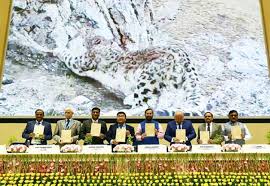
India’s #23for23 Initiative: A Landmark in Snow Leopard Conservation
India’s #23for23 Initiative: A Landmark in Snow Leopard Conservation
On October 23, 2025, coinciding with International Snow Leopard Day, India launched the innovative #23for23 campaign, marking a major step in snow leopard protection. The initiative also unveiled the country’s first National Snow Leopard Census, which recorded 718 individuals across the Indian Himalayan region. This article explores the campaign’s origin, implementation, scientific achievements, and broader significance in India’s wildlife conservation efforts.
Origins of the #23for23 Campaign
The #23for23 initiative was launched by India’s Ministry of Environment, Forest and Climate Change (MoEFCC) in partnership with the Global Snow Leopard and Ecosystem Protection Program (GSLEP) and the Snow Leopard Trust Worldwide. The campaign’s name signifies both the date of International Snow Leopard Day, 23rd October, and the 23 known snow leopard habitats across India.
The program called on citizens from all walks of life—including students, soldiers, government officials, and local communities—to engage in 23 minutes of physical activity, such as walks, treks, or awareness events. This symbolic effort aimed to foster a shared sense of responsibility toward conserving the elusive snow leopard and its fragile mountain ecosystem.
Citizen Participation and Nationwide Outreach
One of the defining features of #23for23 was its integration of public participation with meaningful conservation objectives. Across the Himalayan states, events were organized in collaboration with government institutions, schools, colleges, and local communities. The Indian Army’s participation highlighted the snow leopard’s ecological importance and the nation’s dedication to protecting its high-altitude habitats.
By linking physical activity with environmental awareness, the campaign innovatively combined public health, education, and conservation messaging. Citizens gained firsthand insight into the threats snow leopards face, such as habitat fragmentation, poaching, human-wildlife conflict, and climate change, fostering widespread ecological consciousness.
India’s First National Snow Leopard Census
A key milestone of the initiative was the first-ever scientific census of snow leopards in India, providing baseline data critical for conservation planning. Using methods such as camera traps, field surveys, and genetic sampling, the census recorded 718 snow leopards distributed across Himalayan states as follows:
- Ladakh: 477
- Himachal Pradesh: 51
- Uttarakhand: 71
- Arunachal Pradesh & Sikkim: 61
- Jammu & Kashmir (excluding Ladakh): 58
The findings emphasized Ladakh as a critical stronghold, hosting nearly two-thirds of India’s snow leopard population. This baseline allows policymakers to monitor population trends, plan habitat management, and implement anti-poaching measures with precision.
Ecological and Legal Importance of Snow Leopards
Snow leopards (Panthera uncia) inhabit high-altitude regions between 3,000 and 5,000 meters, spanning twelve countries including India, Nepal, Bhutan, and China. As a keystone species, their presence indicates the health of fragile mountain ecosystems.
The species faces threats such as prey depletion, illegal wildlife trade, habitat loss, and climate change, and is classified as Vulnerable by the International Union for Conservation of Nature (IUCN). In India, snow leopards are legally protected under the Wildlife (Protection) Act, 1972 and international agreements like CITES.
Often called the “Ghost of the Mountains”, snow leopards symbolize both wilderness and ecological integrity. Protecting them is critical not only for biodiversity but also for maintaining sustainable livelihoods dependent on mountain ecosystems.
Science, Community, and Policy Synergy
The #23for23 initiative demonstrates a holistic approach combining science, public engagement, and policy support. The nationwide census represents a landmark scientific achievement, employing cutting-edge technology to produce reliable population data. Such evidence-based information is essential for effective policy design, including habitat management and conflict mitigation.
Simultaneously, the campaign’s emphasis on mass participation fosters a collective responsibility among citizens, highlighting the role of civil society in conservation. Public involvement through treks, awareness drives, and educational programs nurtures a sense of stewardship that extends beyond government-led initiatives.
Additionally, #23for23 aligns with India’s commitments under GSLEP, reflecting the importance of international collaboration in conserving transboundary species. By linking local action with global frameworks, India reinforces its leadership in high-altitude biodiversity protection.
Broader Ecological and Climatic Implications
The initiative goes beyond protecting a single species; it embodies ecological resilience and climate adaptation. Snow leopards are apex predators whose survival maintains the balance of mountain ecosystems, which in turn support water resources, soil fertility, and biodiversity.
By engaging citizens in conservation, promoting evidence-based policies, and leveraging international partnerships, #23for23 creates a replicable model for environmental protection. It encourages harmonizing wildlife conservation with sustainable livelihoods, ecotourism, and climate-resilient land management. The campaign demonstrates that biodiversity preservation and community well-being can advance together, strengthening ecosystem health in the Himalayas.
Lessons and Future Outlook
The #23for23 campaign and the National Snow Leopard Census set a precedent for integrated conservation initiatives. They showcase how public participation, scientific research, and policy interventions can collectively safeguard a species under threat.
Future conservation strategies will benefit from this model by expanding to other endangered species and ecosystems, emphasizing citizen science, data-driven planning, and regional cooperation. Protecting snow leopards will continue to provide ecological, economic, and cultural benefits, supporting livelihoods, tourism, and climate stability in high-altitude regions.
Conclusion
India’s #23for23 initiative, along with the first National Snow Leopard Census, represents a landmark achievement in wildlife conservation. By combining advanced scientific methods, community engagement, and strong policy backing, India has strengthened its role as a global leader in protecting mountain biodiversity. The campaign reinforces the notion that safeguarding the “Ghost of the Mountains” ensures the vitality of entire ecosystems, cultural heritage, and climate stability in the Himalayas. Through #23for23, India has set a model for integrated, participatory, and science-based conservation, offering valuable lessons for the global community in addressing biodiversity loss and environmental challenges.